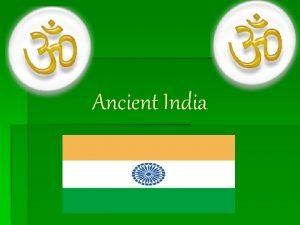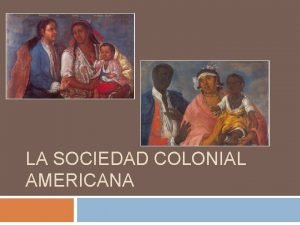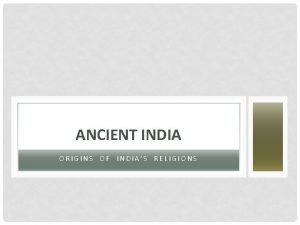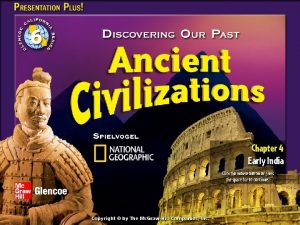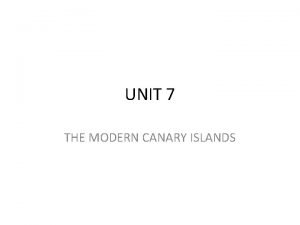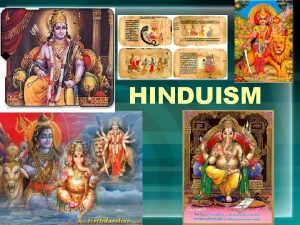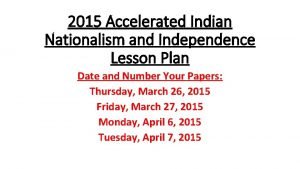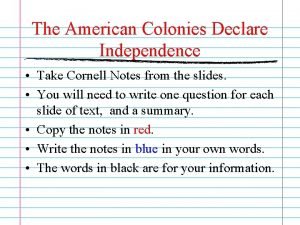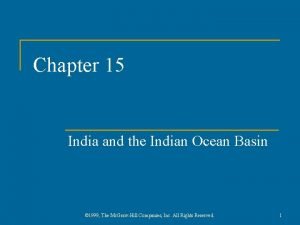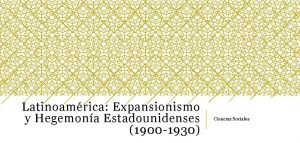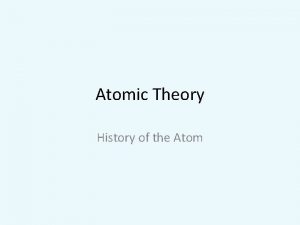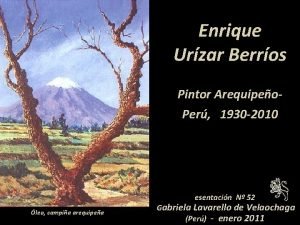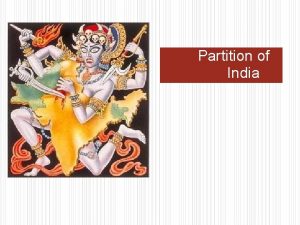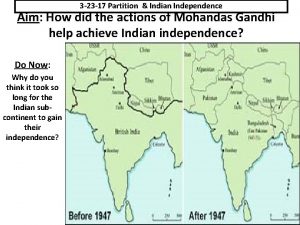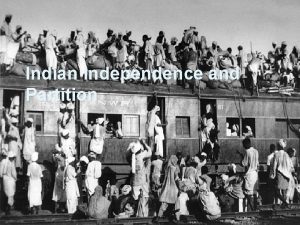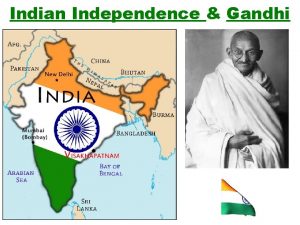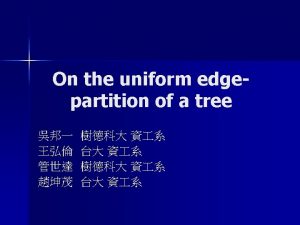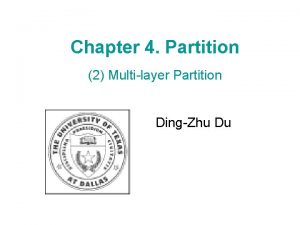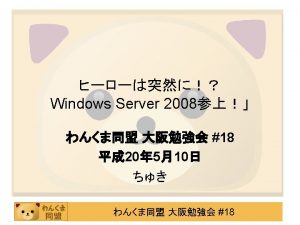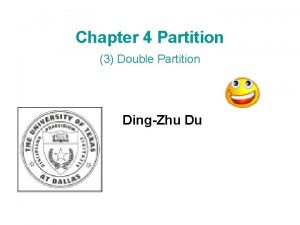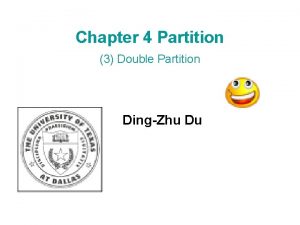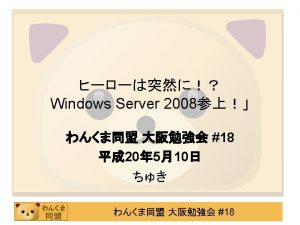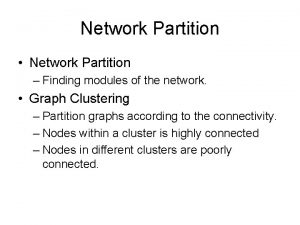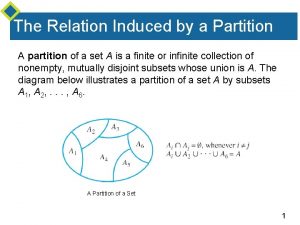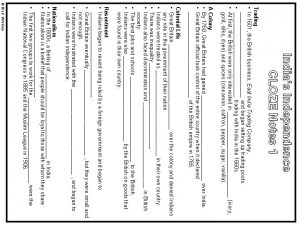Notes on Indian Independence Indias Partition Independence 1930


















- Slides: 18

Notes on Indian Independence

India’s Partition Independence ● 1930 s: ○ Great Britain had granted numerous reforms in response to the tireless campaign of Mohandas K. Gandhi and the Congress Party, as well as Muhammad Ali Jinnah and the Muslim League ● India Act of 1935: gradual release of British power toward Indian self-rule ● Challenge: calls for independent yet separate Hindu and Muslim States ○ India for Hindus and the creation of a new country Pakistan (land of the pure) for Muslims ● WWII paused the drive for self-rule however

The Coming of Self-Rule ● Under the leadership of Winston Churchill, he ordered India to support the war effort ○ He HATED Gandhi! ● After the war, Churchill was voted out of office with his conservative gov. ○ Replaced with a Labour gov. more inclined to dismantle the empire ● The economic devastation of the war made it unrealistic for Britain to continue bearing the financial burden of India

The Coming of Self-Rule ● Issue of Muslim separatism grew in importance as independence became more of a reality ● Muslims increasingly feared their minority status in an India dominated by Hindus ● Prominent leaders ○ ○ Muhammad Ali Jinnah, leader of the Muslim League Jawaharlal Nehru, leader of the Congress Party ● Muslim League called for a separate state → Pakistan ● Congress Party called for union and undivided

The Coming of Self-Rule ● Communalism: emphasizing religious over national identity ● Day of Direct Action ○ ○ ○ August 1946 Muslim League Recognized that Muslim demonstrations might lead to rioting and fighting between Muslims and Hindus 6, 000 ppl died in the event known as the Great Calcutta Killing Jinnah, “the only solution to India’s problem is Pakistan”

Partition and Violence ● Idea of partition and the division of India violated the stated ideals of Gandhi and Nehru ○ Were forced to accepted the idea of a divided and independent India ● Gandhi condemned the division of his homeland ● Independence for India AND Pakistan on August 15 th, 1947 ○ Gandhi prophesied “rivers of blood” would come with this partition

Partition and Violence ● Hundreds of thousands of Muslim and Hindu refugees migrated either to Muslim Pakistan (divided between parts of Bengal in the east and Punjab in the west) or to Hindu India ● mid -1948: estimated ten million refugees journeyed to one of the other sides ○ ○ Btwn half million and one million ppl died in the violence Hostility btwn the migrating parties went into their nearly freed countries

Partition and Violence ● Indian independence between a reality with momentous consequences for the process of decolonization ○ India was the jewel of the British empire and the breakaway of it was a significant turning point ● Gandhi’s nonviolent resistance to British rule inspired nationalists around the globe throughout Asia and Africa! ○ ○ Nehru’s promotion of a nonalignment strategy Was instrumental in a newly independent nations caught in the Cold War

● Nonalignment Movement: goal was to maintain formal neutrality in the Cold War ○ Nonalignment Suffered from a chronic lack of unity among its members and failed to present a united front ● In April 1955, leaders from 23 Asian and 6 African nations met in Indonesia to find an alternative path to choosing either the United States or the Soviet Union ○ Besides neutrality, it stressed the struggle against colonialism and racism

Notes on Vietnamese Independence

Nationalist Struggles in Vietnam ● Vietnam over time had more difficulty in keeping its nationalist struggle for independence separate from the complications of the Cold War ○ Became deeply involved in the Cold War ● Immediately after WWII the Vietnamese first engaged in a battle to free themselves from French colonial control ● Ho Chi Minh, nationalist communist leader, had exploited wartime conditions to advance to cause of Vietnamese Independence

Fighting the French ● The Japanese conquered Vietnam during WWII, effectively pushed out the French rule ○ Ho helped oust them ● Issued the Vietnamese Declaration of Independence, which was modeled on the U. S. declaration ● The French, humiliated by their easy defeat, sought to reclaim their world power status through their imperial possessions

● France started to recapture Vietnam in 1945 ○ Fighting the French Aided by British and US weapons ● Faced with the hostility of the northern nationalist communists, organized as the Viet Minh, the French retook the north brutally ● Vietnamese resistance forces took to the countryside and mounted a campaign of guerrilla warfare ○ ○ Grew increasingly influential in the anti-imperial war 1949: communist China sent aid and arms

The Geneva Conference and Partial Independence ● 1954: peace conference determined that Vietnam should be temporarily divided at the 17 th parallel ○ ○ North Vietnam would be controlled by Ho Chi Minh (communist) South Vietnam would remain in the hands of noncommunists ● With the Korean War and the general feeling of the Cold War, the US lend its support to the French war effort and then to the government of South Vietnam

The Geneva Conference and Partial Independence ● Violating the terms of the Geneva Agreements, which required elections that would likely have brough Ho to power, South Vietnam’s leaders, with US support, avoided elections and sought to build a gov. that would prevent the spread of communism in South Viet. ○ ○ Leader: Ngo Dinh Diem Did not have full popular support

The Geneva Conference and Partial Independence ● 1960 ● Vietnamese nationalists formed the National Liberation Front (NLF) to fight for freedom from South Vietnamese rule ○ Received economic and military assistance from the Soviet Union and China

Vietnam’s “American War” ● Southern gov. continued to be successful from lack of support for Diem ● President Lyndon B. Johnson increased US involvement ○ Ordered bombing campaign against the North and sent ground troops to the South ● Best that the US and South could achieve against the Viet Cong was a draw ● Vietnamese forces fought for freedom from outside interference of any sort and could show patience while making progress toward independence

● 1968: Nixon pledged for his policy of Vietnamization ○ Vietnamese Victory ○ Strategy of turning the war over to the South Vietnamese by escalating the conflict Extended the war into Cambodia ● Opened diplomatic channels to the SU and China to put pressure on the North to end the war ● January 1973: “American War” ended with the negotiated Paris Peace Accords ○ War itself did not end as the NLF continued to conquer the South and unite the nation ● 1976: national reunification by the North
 Indias first empire
Indias first empire Sociedad colonial americana
Sociedad colonial americana Indias religions
Indias religions Indias first civilization
Indias first civilization The maurya and gupta empires
The maurya and gupta empires Indias religions
Indias religions Flota de indias ruta
Flota de indias ruta What is indias main religion
What is indias main religion Caste system in india
Caste system in india Nationalism in europe lesson plan
Nationalism in europe lesson plan Cornell notes on the declaration of independence
Cornell notes on the declaration of independence Chapter 15 india and the indian ocean basin notes
Chapter 15 india and the indian ocean basin notes Kjent advokat 1930-1996
Kjent advokat 1930-1996 Moralismo pedagógico
Moralismo pedagógico History of atom models
History of atom models 1930 pop culture
1930 pop culture Fashion 1930 to 1940
Fashion 1930 to 1940 2010-1930
2010-1930 Moda 1920
Moda 1920
